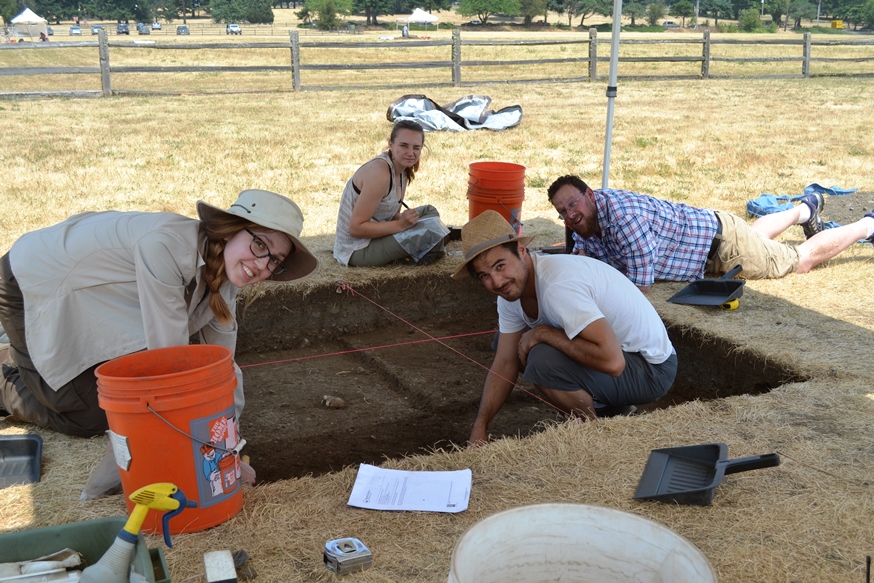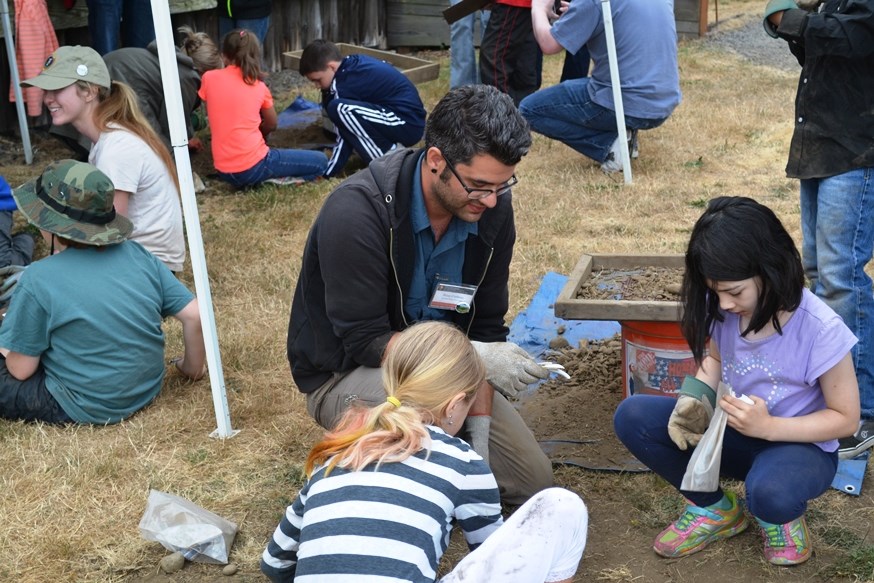|
You are viewing ARCHIVED content published online before January 20, 2025.
Please note that this content is NOT UPDATED, and links may not work. For current information,
visit https://www.nps.gov/aboutus/news/index.htm.

NPS PHOTO
Contact: Douglas C. Wilson, National Park Service Archaeologist, 360-816-6251 Fort Vancouver National Historic Site invites the public to engage with archaeologists and archaeology at one of the Pacific Northwest's premier archaeological sites. This summer's Public Archaeology Field School will give visitors the opportunity to interact with student archaeologists as they uncover history, Kids Digs will allow children to experience the science (and fun!) of an archaeological excavation, and a public lecture series will bring archaeologists from around the country to the national park to discuss their work. The Public Archaeology Field School is a joint undertaking of the Northwest Cultural Resources Institute at Fort Vancouver National Historic Site (National Park Service), Portland State University, and Washington State University Vancouver. The Northwest Cultural Resources Institute is dedicated to facilitating cultural resource education and research activities in the region, through cooperative partnerships at Fort Vancouver National Historic Site and at other Northwest national parks. Fort Vancouver the premier historical archaeological site in the Pacific Northwest, provides a dynamic, place-based learning environment for public and academic programs.
2016 Public Archaeology Field School This summer, National Park Service archaeologists are teaming up with Portland State University and Washington State University Vancouver to conduct archaeological excavations. Students and professionals will dig east of the fort stockade, near the Spruce Mill Trail west of Pearson Air Museum, as well as on the national parks' waterfront. The excavations will focus on the World War I Spruce Mill, and the Fort Vancouver Waterfront Complex. From 9:00 am to 4:00 pm, Tuesday through Saturday, June 28 - July 30 (excluding July 4), the Spruce Mill dig site will be accessible to the public. The Waterfront Complex dig site will be accessible 9:00 am to 3:00 pm on Thursdays and Fridays, June 30 through July 29. The U.S. Army's Spruce Production Division operated the Spruce Mill from 1917 to 1918 to produce lumber for Allied aircraft manufacturing during World War I. Students will perform test excavations at the site of the main mill, repair and machine shop areas, as well as the site where mill workers' bunkhouses and tents were located. The Spruce Mill played an important role in the development and use of military aircraft. The excavations are part of a continued effort to learn more about the mill's contribution to the war effort. The Hudson's Bay Company's Fort Vancouver, which stood from 1825 to 1860, was the regional headquarters and supply depot for the Company's operations in the Pacific Northwest. The Hudson's Bay Company Waterfront Complex included a wharf, boat works, salmon "store" or salting structure, a hospital, dwellings, and other buildings that supported the Company's agricultural and commercial enterprises in the area. Later in the 19th century, the U.S. Army used the site for its wharf and quartermaster's depot, and in the 20th century, it served as a U.S. Coast Guard station. Students will be surveying this area on Thursdays and Fridays using small test probes called "constant volume samples." "We are very excited to participate in this public archaeology program during the centennial year of the National Park Service," said Douglas C. Wilson, National Park Service Archaeologist and Principal Investigator of the project. "We look forward to the many visitors who will get the opportunity to talk to students and staff about the importance of this premier heritage site." Directions to both sites can be found at the Ranger Station inside the gates of the reconstructed Fort Vancouver, or at the park's Visitor Center.
Kids Dig! The popular Kids Dig! program introduces kids ages 8 through 12 to the fascinating world of archaeology. In this program, kids excavate a mock site with the help of student archaeologists, and discover what we can learn about the past from the artifacts buried under our feet. Kids Dig! programs will take place on July 2, July 9, and July 23 at 10:30 am and 2:00 pm, inside the reconstructed Fort Vancouver. Space is limited to 20 children. Spots for each program can be reserved in advance by calling (360) 816-6250. Learn more here.
Lecture Series Public lectures in this series explore archaeology with particular ties to the historical archaeology and the archaeology of the region. All lectures take place at 7:00 pm in the Tex Rankin Theater at Pearson Air Museum, with the exception of the July 20 lecture, which will take place at the Cannon Beach History Center and Museum at Cannon Beach, Oregon.
One of the founding principles of the National Park Service (NPS) is the idea of preserving park resources for "future generations." Now, in the midst of its centennial anniversary celebration, the NPS seeks to engage today's youth through various programs including archaeology and other cultural disciplines. America's special places offer unique opportunities to engage young people from many backgrounds through the practice of archaeological research. Citizen science programs within national parks are hands-on history at its best, where young stewards are active participants in the research process. This presentation will discuss public archaeology in the context of the NPS Centennial, provide example projects from the Midwest where NPS archaeologists are engaging future generations, examine the strengths and challenges of public engagement through archaeology, and look to the future of public archaeology for the next generation of the National Park System .
Pickawillany was a large 18th century Miami Indian town located near the junction of Loramie Creek and the Great Miami River. In 1748, the Miami allowed the English to open a trading enterprise there in open defiance to the French, who claimed all of the Ohio country north and west of the Ohio River. Despite repeated French protests concerning the Miami's interactions with the English, and diplomatic attempts to return them to the French alliance, the Miami remained firmly attached to their newfound benefactors. Failing to bring the Miami back into line by any other means, the French attacked and destroyed Pickawillany in June 1752, an event that pushed North America down a slippery slope toward the greater conflict knows as the French and Indian War. This presentation will discuss the comprehensive research program at Pickawillany to rediscover and explore the site of this historic event.
The Gifford Pinchot National Forest's heritage is embodied in objects, sites, and buildings. Mr. Donnermeyer will highlight some of the over 1,500 heritage resource sites that have been documented on the Gifford Pinchot National Forest, including prehistoric archaeological sites, historic American Indian sites, and historic structures. He will explore how the heritage program studies and preserves these sites.
The Middle Village is a contact-period Chinook Indian village in the estuarine zone near the mouth of the Columbia River. This site contains abundant fur trade era goods and well-preserved architectural features associated with at least three plank structures. Early fur traders and explorers described the village as having been in the same location as Lewis & Clark's Station Camp. The excavations of this important site suggest the intensity and context of interaction between the Chinook and Euro-American fur traders.
One cannot fully comprehend the European colonial experience in the Americas without understanding its African counterpart. Dr. Singleton will explore African American life through historical archaeology, including her recent work at the Cuban plantation site of Santa Ana de Biajacas. She will address issues of cultural identity, race, gender, and class; cultural interactions and change; relations of power and domination; and the sociopolitics of archaeological practice. 
NPS PHOTO |
Last updated: June 14, 2016
